What has the Mini Cooper got that the VW Beetle lacked?
The question arises because the Mini is still here – while the Beetle isn’t. The resurrected icon was initially very popular when VW brought it back in the late ‘90s but became less so after it was significantly restyled in 2010 – made to look sleeker and more aggressive – in 2010.
VW cancelled it in 2019.
Lesson: Don’t fix what isn’t broken.
Mini didn’t make that mistake. Which probably explains why it’s still around.
What It Is
The BMW Mini Cooper is the resurrected, modernized version of the iconic British Mini Cooper of the ‘60s. Like its ancestor, it is small and pugnacious while managing to maintain a friendly, approachable demeanor.
Almost everyone seems to like them.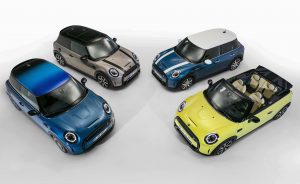
It is also currently the smallest new car you can buy, the hardtop coupe being only 152.2 inches long, end to end. For some sense of scale, a subcompact sedan like the Hyundai Accent is 172.6 inches long and a kinda-sorta subcompact rival like the Hyundai Veloster three-door “coupe” is 166.9 inches long overall.
It also has the smallest standard engine put into a new car – just three cylinders and 1.5 liters. It is also one of the very small handful of new cars still available with a manual transmission – and your choice of two other engines that can be paired with it.
The standard two-door hardtop stickers for $22,900 to start; it comes with the above-mentioned 1.5 liter engine and a six-speed manual transmission.
An S trim – which comes with a more powerful 2.0 liter engine, also paired with the six speed manual – stickers for $26,900.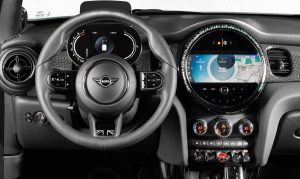
At the pinnacle of power/performance is the John Cooper Works (JCW) version, which has the same size 2.0 liter engine but with modifications that amp up the power from 192 (in the S) to 231, plus a complementary host of performance and visual upgrades. It stickers for $32,900 to start with the six-speed manual transmission.
There are also four-door versions of the same thing and convertible versions of the same thing, topping out at $44,900 for a JCW convertible with an eight speed automatic and the Iconic trim package.
Plus, an electric version – the Cooper SE. It stickers for $29,900.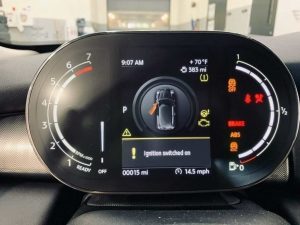
Nominal cross-shops include models like the Hyundai Veloster and the VW Golf/GTI – but these are both larger cars, hardtop-only cars and are not iconic cars. The Beetle was small – and iconic – and it offered a soft-top.
But it’s not around anymore to vie for buyers with the Mini.
What’s New
All Minis get a subtle exterior and interior refresh, the most obvious change being inside – where a new tablet-style flatscreen main gauge cluster is perched on the steering column, replacing traditional gauges built into the dash. The secondary display for the apps/infotainment is larger and there is a new “multi-tone” color shifting top.
All trims (and doors and tops) also now come standard with Lane Departure Warning, Active Driving Assistance and Sirius/XM satellite radio.
What’s Good
As iconic as ever.
Upright posture and roofline gives this small car big car headroom – including in the back seat.
Two or four doors; hard or soft top; manual or automatic transmission.
What’s Not So Good
All engines want premium unleaded fuel and come standard with a turbocharger – which adds boost but also expense (and pressure).
Convertible JCW is automatic-only and convertible top costs cargo space, which is reduced to almost none.
Kinda-sorta rivals like the Veloster cost substantially less ($18,900 to start).
Few new cars offer more than a standard and one optional engine – and most come with just one (automatic) transmission. The Mini comes standard with a turbocharged 1.5 liter, three cylinder engine that makes 136 horsepower and is available with your pick of two versions of a 2.0 liter four cylinder engine (also turbocharged). The first – in the S – makes 192 horsepower.
The second – in the JCW – makes 231.
All three of these engines are available with a six speed manual transmission or (optionally) an eight speed automatic – unless you want a convertible JCW, in which case the automatic is standard.
There is also the option to skip the engine – and transmission – altogether. The Mini SE has a battery-powered 184 hp electric motor that drives the wheels directly.
These four options let you decide how quickly – and how far – you’d like to go.
The base-engined Mini gets to 60 in 7.6 seconds and gets 26 city, 37 highway. It also goes 429 miles on the highway on a full tank of gas. If you opt for the S, you’ll get to 60 in 6.4 seconds and get 23 city, 33 highway. You’ll also be able to go about 382 miles on the highway before you’ll have to stop to refill the tank. The JCW Mini is the quickest of the bunch, getting to 60 in 5.9 seconds – but it doesn’t use any more gas or go less far than the Cooper S, at least on paper.
It’s capable of achieving the same 23 city, 33 highway – and going the same 382 miles, before it runs out of gas . . . provided you don’t run it as hard as it’s capable of running. Using the extra boost it is capable of summoning will of course result in burning more gas and going not quite as far.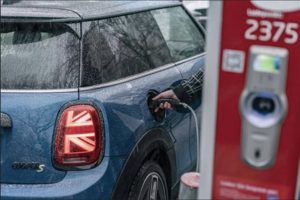
The fourth option – the electric option – gets you to 60 in 6.9 seconds, which is quicker than the base-engined Mini and nearly as quick as the Mini S – without burning any gas at all. But it only goes about 110 miles before you have to stop for a recharge, which takes much longer than a refill – even if you can find what is curiously styled a “fast” charger. These are “faster” than plugging in to a standard 120 volt household outlet – which takes overnight to recharge (and four hours if you have a 240 volt circuit to plug into). But they still take at least 30-45 minutes longer to instill a partial (about 80 percent of capacity) recharge than the five or less minutes it takes to fully refill a gas-engined Mini’s 11.8 gallon fuel tank.
But you can plug in at home. And you can’t refill at home.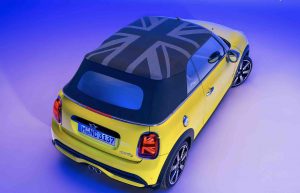
There is also the possibility of using solar to charge the Mini – albeit slowly. And potentially for free – if you don’t count the cost of the solar equipment. And don’t factor in the much higher cost of the electric Mini, itself.
All Minis – whether gas-engined or battery-powered – are front-wheel-drive.
On The Road
Being tiny has its advantages – especially when almost everything else is huge. The Mini can Frogger in between the lumbering behemoths, taking advantage of briefly opening gaps in traffic closed to the super-sized SUVs and crossovers that populate the landscape. The Mini’s short-wheelbased agility allows almost parking brake 180 U turns – without actually using the parking brake to make them. You can also slot right into parking spots that the sheetmetal sauropods must lumber past – and without even having to maneuver into them.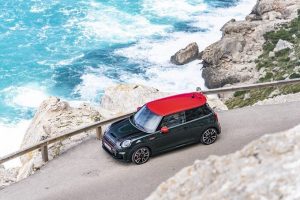
You’ll have room in your garage for more than just your car, too.
But the main reason for driving a Mini is that it is fun to drive a Mini. Especially a manual Mini and particularly with its standard engine. Which isn’t a powerful engine. The turbo snuggled up close to the little three cylinder’s exhaust ports does enhance the power – and the torque – developing what there is sooner (at lower RPM) which is always helpful in terms of off-the-line giddyap. But there is nothing that makes a not-very-powerful engine feel like it has more power than a manual transmission and no automatic can give you the same control over the engine that a manual does.
The Mini comes standard with one – at a time when the manual transmission has become almost as hard to find in a new car as wing vent windows. And if you choose the automatic, the turbo’d torque is just the ticket for getting you going that way, too.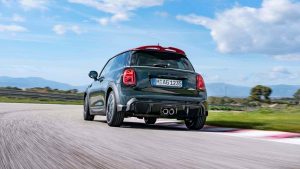
The short-wheelbased ride can, however, be a little choppy (it’s more noticeably so in the S and JCW versions, which have firmer suspensions and more aggressive, shorter-sidewall tires, which enhance the effect) and being tiny amid a herd of behemoths means it’s more likely one of them may not see you.
Be careful not to get trampled.
The Mini offers more configurations than rivals like the three-door-only (and hardtop-only) Veloster and the five-door (and hardtop-only) VW Golf/GTI.
You can go two – or four – doors. Metal – or cloth – top.
And you might be surprised to discover how big the Mini is – inside. Even the two-door version, which has 30.8 inches of backseat legroom and an almost unbelievable 34 cubic feet of cargo capacity. The Hyundai Veloster bests both these stats – with 34.1 inches of backseat legroom and 44.5 cubic feet of total cargo capacity – but it’s a significantly larger (longer) car and the severe slope of its roofline, which also overlaps the rear door opening, can make getting into and out of the back seats extremely awkward for adults.
The Mini’s available convertible top is another hard-to-find-feature in new cars generally. Particularly in relatively practical cars like the Mini, with usable rear seats (sports cars like the Mazda Miata have soft tops haven’t got back seats at all and you can’t get a four-door Mustang or Camaro convertible).
There is a downside, though. In a car this tiny there is not much room for the top – when it’s down, especially. But even with the top up, there is very little “trunk” – just 7.6 cubic feet, tucked behind a fold-out trunk-tray in the back. You can’t put much back there – and not just because the space is small.
So is the opening.
But, you’ve still got the back seats – and with the top down, you can use the vertical space you can’t avail yourself of in the hardtop-only competition.
Mini (BMW, actually – which owns Mini) hasn’t made the mistake of fundamentally changing the Mini, which was the mistake VW made with the Beetle. The ’21 gets a few minor stylistic tweaks, such as a slightly different grille shape, but the iconic face and shape remain the same as ever. As cute as ever, without crossing over into too cute or too butch. That is the secret recipe here. The Mini is a car that a young woman or a middle-aged man can drive and not feel or look mismatched driving.
It is also, arguably, more faithfully iconic than the resurrected Beetle was – and for that reason, no longer is. The original Beetle was rear-engined and air-cooled. It was an extremely simple, user-fixable car and that plus its cuteness was a big part of its multi-generational appeal. But the resurrected Beetle merely looked like the iconic Beetle. It was front-engined, water-cooled and not especially user-fixable.
The current Mini is much more faithful to the original Mini in both form and function. Certainly, it is a complex car – as all modern cars are. But the essential Mini-ness of the thing is still there and that probably explains why it survives and thrives while the resurrected Beetle didn’t.
The Bottom Line
Never fix what ain’t broke.
. . .
Got a question about cars, Libertarian politics – or anything else? Click on the “ask Eric” link and send ’em in!
If you like what you’ve found here please consider supporting EPautos.
We depend on you to keep the wheels turning!
Our donate button is here.
If you prefer not to use PayPal, our mailing address is:
EPautos
721 Hummingbird Lane SE
Copper Hill, VA 24079
PS: Get an EPautos magnet or sticker or coaster in return for a $20 or more one-time donation or a $10 or more monthly recurring donation. (Please be sure to tell us you want a magnet or sticker or coaster – and also, provide an address, so we know where to mail the thing!)
My eBook about car buying (new and used) is also available for your favorite price – free! Click here. If that fails, email me at [email protected] and I will send you a copy directly!




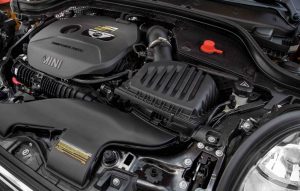

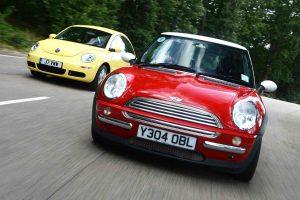








Is it just me or are digital displays just ugly?
Hi Landru,
I don’t like them, either – but I’m a Gen X guy who grew up before digital displays and so it may just be a generational thing. The Youf seem to like it, which is part of the reason for their ubiquity. But there is also another reason: Digital dashes are cheap. They are a way to cut costs and increase profits – on the front and back end.
The Youf? As in “youtes”?
Also, yeah, I saw a Mini Cooper pass me yesterday, and I thought of this article and the digital dashboard. The old analog unit is definitely more attractive, and although I can see the utility of the digital screen, I really don’t like it as much.
I will give Mini credit for the toggle switches, however. A car can’t have enough of those.
Build mini highways for mini cars. Do it for the children!
Corolla, Gremlin, AMC Lark, Corvair, Maverick, similar makes and models, no other cars can drive the mini roads. Sounds like downtown London for the Mini Cooper. You can drive your Cortina down Penny Lane in Liverpool.
Drove a Lark for about a year, your basic company car bought for not too much dough, revved the six-cylinder engine so fast I sheared the timing pin. My dad fixed it, on the road again. There it was, gone.
Lew Rockwell featured an opinion piece by Bionic Mosquito, The Sons of Disobedience. Worth reading.
When my second son was about eight years old, he was dressed in a white shirt and tie. “The next time you see me in this, I’ll be dead,” he said. Too funny. Wry as hell. lol
Joe Biden is a victim of Munchausen syndrome by proxy. Factitious disorder. The man is in la-la land, he is being used and abused because of it. Not very ethical.
The man needs help, obviously.
I wonder, when people die and are buried, will they request to have a mask on in their coffins?
Perspiring minds need to know.
Get those masks on, you ignorant slaves!
Personally I think the later “squashed” bug is vastly better looking. But having owned 2, I find the quality and maintain ability of the new beetle are crap. Germans dont seem to do good plastic or electronics. Which also scares me off from trying a “Mini” BMW…
always have been on the fence about minis.
with a stick and hearing they are fun to drive, maybe it’s worth stopping by a dealer for a test.
storage capacity always put this in the not considered list however.
They do a nice job of competing with the Miata. But the looks are still love-it-or-hate-it precious. The last Beetle was a “chick car” even to the point of putting a flower vase on the dash. These feel like someone is going to explain to me exactly what makes it so wonderful, followed by me responding “yea, I get it, but it still isn’t a 911.”
Granted I’m just speculating…
Actually, probably should plan on replying “yea, I get it, but it still isn’t a Miata…”
I like it.
Now, anyone notice what sounded like TIE fighters flying past in Eric’s video?
Things I’ve noticed in my 20 years of driving Miatas:
Other drivers don’t see you as well.
Backing out of a parking space between a couple of pickups, SUVs, and many ordinary cars is a gamble that as you slowly ease back, the other driver will see you and at least honk their horn, if not stop and let you out. Which is often not what happens.
I was once run off the road on a dual lane highway and spun out in the median. One of my car guy coworkers said “you probably would have rolled in another car”, to which I replied “yeah, but the other driver might have seen me and NOT run me off the road.”
‘gamble that as you slowly ease back, the other driver will see you’ — JK
Easily fixed, John, with the automotive equivalent of giant clown shoes:
http://www.stanceiseverything.com/wp-content/uploads/2010/01/miata1bz.jpg
good stuff. love the miata idea but was thinking about everyday issues of owning just like that
If you love to drive, I mean really drive, the good outweighs the bad. By a lot. I’ve driven a lot of cars, from Porsches to Corvettes, and nothing handles like a Miata. Not a lot of power, which probably keeps one out of trouble.
The one bad thing, which doesn’t apply to me, is if you’re much taller than 6′, it may not be for you.
Agreed on the Miata. I’ve owned my going on 32 years old Miata for 20 years now. But you spoke of handling and I got my butt stomped by a Mini once on the TotD. I upgraded the sway bars and tires and that did not happen again.
Power wise, I have an aftermarket supercharger kit on mine. Probably one of the first kits to ever hit the market back in the day by my research (supercharger installed already when I bought it). I absolutely think that anyone that felt they needed a little more power out of a Miata, forced induction was the way to go. Cost wise, it wasn’t prohibitive. Back in the day, decent used Miata + Supercharger kit = Mazdarati.
‘It also has the smallest standard engine put into a new car – just three cylinders and 1.5 liters.’ — EP
What’s good about three cylinders
Physically small; light in weight; fewer moving parts than a 4-cylinder.
What’s not so good
An inherently balanced inline six, butchered in half to make a 3-cylinder, becomes inherently unbalanced … and potentially rough as a cob.
https://www.carthrottle.com/post/heres-the-problem-with-three-cylinder-engines/
Three is an attractive number in many respects. A triangle is an inherently stable polygon.
But a three-cylinder engine may be the automotive equivalent of a three-breasted woman — a bit off-putting to a conventional sensibility.
Note that the notorious Kawasaki 750 cc Widowmaker triple was a two-stroke, with power pulses every 120 degrees of crankshaft rotation, versus every 240 degrees for a four-stroke triple.